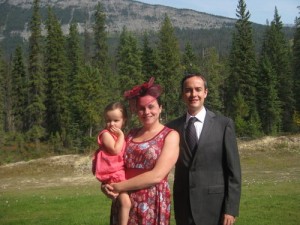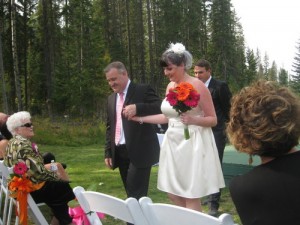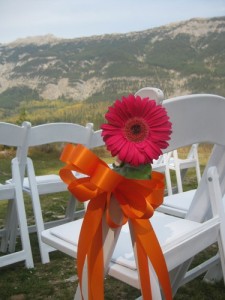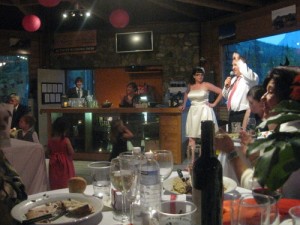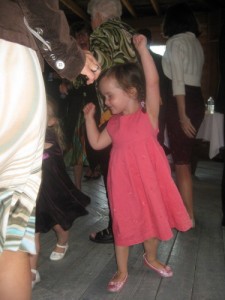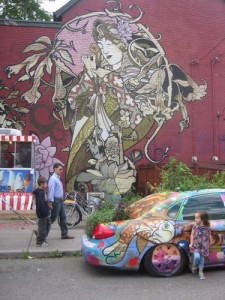September 30, 2012
Block Letters
 Yesterday we dared to skip nap to attend the Block Letters event at the Lillian H. Smith Library, as part of Culture Days. The show began with Cybele Young reading from her book A Few Blocks, which we’ve been fans of for a while, as well as from Ten Birds, and from her latest book, A Few Bites, which we were happy to purchase for ourselves.
Yesterday we dared to skip nap to attend the Block Letters event at the Lillian H. Smith Library, as part of Culture Days. The show began with Cybele Young reading from her book A Few Blocks, which we’ve been fans of for a while, as well as from Ten Birds, and from her latest book, A Few Bites, which we were happy to purchase for ourselves.
 After the reading, the kids were given a map of the neighbourhood, and we all left the library to go for a walk together. Not just any walk, however. It was an ordinary walk bursting with stories and imagination, similar to the one partaken by Ferdie and Viola in Cybele Young’s books. A little bit of imagination transforms an ordinary walk into an extraordinary adventure. We found a shoe, an empty lake, a strange tower with “Danger No Admittance” on its door. Where did the shoe come from? Why was the lake empty? What was inside the tower? (For the last, the kids came up with a hypothesis involving diamonds, a princess and the British King.)
After the reading, the kids were given a map of the neighbourhood, and we all left the library to go for a walk together. Not just any walk, however. It was an ordinary walk bursting with stories and imagination, similar to the one partaken by Ferdie and Viola in Cybele Young’s books. A little bit of imagination transforms an ordinary walk into an extraordinary adventure. We found a shoe, an empty lake, a strange tower with “Danger No Admittance” on its door. Where did the shoe come from? Why was the lake empty? What was inside the tower? (For the last, the kids came up with a hypothesis involving diamonds, a princess and the British King.)
We explored the alleys and strange pathways of the UofT campus, wondered where all the big rocks along Huron Street had come from, found a secret forest whose trees were sleeping monsters (who turned into rhinos if awakened), and began noticing small, wonderful things we might not have paid attention to before. What’s going on down in the sewer? The sound of streetcars passing? We discovered that everywhere is steeped in wonderment in you only stretch your mind enough to note it.
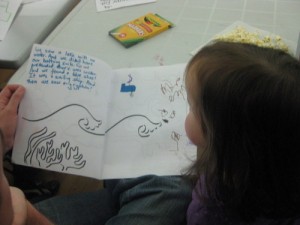 Returning to the library (its own wondrous destination, with gryphons guarding its doorway), kids were equipped with markers and crayons, plus their own storybook with Cybele Young’s drawings inside and enough blank spaces for them to collaborate and tell their own stories of neighbourhood walk. Harriet dictated her tale, and drew some scrawly pictures in Harriet styly. Stuart and I helped her out so it became a bit of a family project.
Returning to the library (its own wondrous destination, with gryphons guarding its doorway), kids were equipped with markers and crayons, plus their own storybook with Cybele Young’s drawings inside and enough blank spaces for them to collaborate and tell their own stories of neighbourhood walk. Harriet dictated her tale, and drew some scrawly pictures in Harriet styly. Stuart and I helped her out so it became a bit of a family project.
There was popcorn, fun and plenty of inspiration. More than anyone could ask for from a Saturday afternoon.
September 27, 2012
Our Western Whirlwind
 Whew, speaking of roadtrips. We had a wonderful, crazy, whirlwind trip to the mountains this week. We arrived in Calgary on Thursday and drove to Banff where we met up with my family and my sister’s friends for a bbq at my sister’s house. The next morning, we hung out in Banff and were delighted to discover a new independent bookstore in town, the lovely Mooseprint Books. (So wonderfully curated! They had Native Trees of Canada with their nature books, and Above All Things in with the mountain guides.)
Whew, speaking of roadtrips. We had a wonderful, crazy, whirlwind trip to the mountains this week. We arrived in Calgary on Thursday and drove to Banff where we met up with my family and my sister’s friends for a bbq at my sister’s house. The next morning, we hung out in Banff and were delighted to discover a new independent bookstore in town, the lovely Mooseprint Books. (So wonderfully curated! They had Native Trees of Canada with their nature books, and Above All Things in with the mountain guides.)
It was especially exciting because I was able to see all kinds of West-centric books for the first time that we’ve been featuring on 49thShelf, including Foodshelf: An Edible Alberta Alphabet by dee Hobsbawn-Smith. I’ll admit that Albertan food was not exactly a passion of mine, but: I have been mad about this book’s cover design since the first time I saw it, and I LOVE alphabet books, which rarely cater to my reading level and so I had to own this. I was not sorry. It turns out that reading about Alberta’s food culture is the most splendid way to learn about Alberta proper– its demographics, culture, topography, geography, climate, politics, and environment. It was an extraordinary education, and wholly engaging to read.
 On Friday, we drove to Golden BC to have lunch and a browse at Bacchus Books. Harriet got Kitten’s First Full Moon and Stuart (who’s on a David Mitchell kick) got Number9Dream. We arrived at the wedding site on the banks of Kicking Horse River and got ready for two days of wedding fun. The wedding was complete with friendly, fun guests, and hosts who went to the ends of the earth to ensure that fun was had by all. It was. Such a stunning backdrop for the party too. Harriet was a dancing queen, and everybody was thrilled and honoured to be there.
On Friday, we drove to Golden BC to have lunch and a browse at Bacchus Books. Harriet got Kitten’s First Full Moon and Stuart (who’s on a David Mitchell kick) got Number9Dream. We arrived at the wedding site on the banks of Kicking Horse River and got ready for two days of wedding fun. The wedding was complete with friendly, fun guests, and hosts who went to the ends of the earth to ensure that fun was had by all. It was. Such a stunning backdrop for the party too. Harriet was a dancing queen, and everybody was thrilled and honoured to be there.
 We spent most of Sunday in Banff, when we weren’t on the road, riding a Gondola up to the mountain top and going to buy more books at Moose Print. (Harriet got Big Bear Hug as a Rocky Mountains souvenir). Dinner was had at our favourite Canmore joint, the wondrous Rocky Mountain Flatbread. And then on Monday morning we drove to Calgary. (It was also at this point that it occurred to us that we’d gone to too many places, and Harriet was confused about sleeping in a different bed every night.)
We spent most of Sunday in Banff, when we weren’t on the road, riding a Gondola up to the mountain top and going to buy more books at Moose Print. (Harriet got Big Bear Hug as a Rocky Mountains souvenir). Dinner was had at our favourite Canmore joint, the wondrous Rocky Mountain Flatbread. And then on Monday morning we drove to Calgary. (It was also at this point that it occurred to us that we’d gone to too many places, and Harriet was confused about sleeping in a different bed every night.)
Oh, we learned that Calgarians are most hospitable. We were treated to lunch by Melanie and her family, and it was so nice to finally meet. Our children had a wonderful time playing together, and the pie was delicious. Afterwards, we drove out to stay with Melissa and her family, who had decided to put us up as house guests event though six people lived in their house already and Melissa hadn’t seen me in 17 years. Harriet was enchanted by the big kids, and we were made to feel as though we were home. On Tuesday, we met up with my friend Sue who I hadn’t seen in 7 years, and once again, Harriet had wonderful kids to play with. We visited a farm and braved a toddlerific restaurant meal, and then Harriet had a nap in their spare room.
 We decided it would be important to see some part of Calgary that wasn’t a suburb, however splendid were its inhabitants, so we ventured downtownish in the evening. Naturally, our pilgrimage would be to Pages on Kensingston, which was as wonderful as I’d been hoping it would be. Stuart and Harriet settled in to read stories while I browsed. I picked up the new Nicola Barker novel, The Yips (so good!), The Book of Marvels as a gift for our hostess, and Harriet was quite insistent upon owning a copy of The Obstinate Pen (good choice!). Then we went to a toy store where Stuart caused trouble, and went walking along the Bow River and crossed a pedestrian bridge or two. The aspens were beautiful!
We decided it would be important to see some part of Calgary that wasn’t a suburb, however splendid were its inhabitants, so we ventured downtownish in the evening. Naturally, our pilgrimage would be to Pages on Kensingston, which was as wonderful as I’d been hoping it would be. Stuart and Harriet settled in to read stories while I browsed. I picked up the new Nicola Barker novel, The Yips (so good!), The Book of Marvels as a gift for our hostess, and Harriet was quite insistent upon owning a copy of The Obstinate Pen (good choice!). Then we went to a toy store where Stuart caused trouble, and went walking along the Bow River and crossed a pedestrian bridge or two. The aspens were beautiful!
Flight home was uneventful, or if it wasn’t, I didn’t notice because I was too busy reading Nicola Barker. We arrived home last night and are so glad to be back, as glad as we are exhausted, and the memories of the fun we had are as golden as the trees were.
September 19, 2012
Cadillac Couches by Sophie B. Watson
 It’s nice when you can tell a book by its cover, in particular when the cover looks like this one. Though I may have always been destined to love Cadillac Couches, the first novel by Sophie B. Watson. After all, it contains the following paragraph: “Eating popcorn and chocolate. Smoking smokes, drinking diet pop. Everything happened in the Cadillac. What larks! But like Bob Geldof asked in one of my favourite books–his autobiography Is that It?–was that it?” But that’s not it, of course, even if it would be enough if it were because I did read Is that It? so many times in high school that its pages fell out and I cut out its pictures (Bob Geldof in overalls) and stuck them on them bedroom wall.
It’s nice when you can tell a book by its cover, in particular when the cover looks like this one. Though I may have always been destined to love Cadillac Couches, the first novel by Sophie B. Watson. After all, it contains the following paragraph: “Eating popcorn and chocolate. Smoking smokes, drinking diet pop. Everything happened in the Cadillac. What larks! But like Bob Geldof asked in one of my favourite books–his autobiography Is that It?–was that it?” But that’s not it, of course, even if it would be enough if it were because I did read Is that It? so many times in high school that its pages fell out and I cut out its pictures (Bob Geldof in overalls) and stuck them on them bedroom wall.
I really liked Cadillac Couches, a silly, sprawling road-trip novel with its very own soundtrack. The story begins at the Edmonton Folk Festival, where music fanatic Annie Jones (“But I didn’t know an arpeggio from an armadillo–I was doomed to be forever a fan, not a player”) decides that the cure for her heartbreak just might be a cross-country road-trip with her best friend Isobel to see Hawksley Workman performing a free show in Montreal. They stop off at the Winnipeg Folk Festival en-route, Annie discovers Ani DiFranco and is half-transformed, they have a breakdown in Wawa, max out their credit cards, and have to busk in order to earn enough money to keep the gas tank topped up. Annie is convinced if they can just make their way to Hawksley that he will fall in love her, and her half-transformation will be complete.
Of course, the road trip narrative one is a familiar one from other books and films, but it fast becomes clear that this one is a road less travelled. There is a bawdiness to Watson’s writing– by page 69, Annie has already masturbated, and also peed in the tub (which her cheating boyfriend gets into as Annie gets out). The narrative itself is meandering, moving in and out of time, referring to other trips that Annie and Isobel have taken together. It’s also scattered with song lyrics, and references to books and movies which Europhiles Annie and Isobel revere. It’s a messy book about messy people, but though it’s sometimes silly, it’s not stupid, and there is substance underneath the whimsy.
Though sometimes it’s too messy in places. Perhaps I’m harping on the Geldof thing, but if Is that It? were one of you’re favourite books, you probably wouldn’t have to say, “And I think I read Paula Yates was a girl just hanging around the music scene when she hooked up with Bob Geldof”. You’d know it. And though Watson herself holds transatlantic status, her character doesn’t, and so it was weird that so much of Annie’s vernacular was made up of Britishisms. I wanted too more of a dynamic between Annie and Isobel (who was suffering a strange fake-bilingual affectation) who seemed strangers to one another, though Watson does do an effective job if showing how travel wears a friendship down.
The novel’s roughness is part of its charm though, underlined by the line drawings throughout and the soundtrack included at the end. The whole package casts a spell. For those of us who came of age in the 1990s, Cadillac Couches is a bit like a scrapbook, the coolest bits of every diary you ever kept. Watson shuns convention with her book’s conclusion too, its happily ever after coming courtesy of a refreshing dose of grrrl power.
September 18, 2012
Mr. King's Things by Genevieve Cote
 I cannot really claim any objectivity in my adoration of Genevieve Cote’s new book Mr. King’s Things, because a character in it was named after my daughter, which is certainly some kind of conflict of interest. I met Genevieve in 2008 on a rather glorious adventure, and we’ve kept in touch ever since, our bond cemented over a mutual love of teapots (she puts them in all her books!) and my admiration for her work. I was 4 months pregnant with Harriet when she signed me a copy of What Elephant?, and since then, Genevieve’s books have made up a beloved corner of our library: her companion books Me and You and Without You, and also The Lady of Shalott. And we’re especially in love with Mr. King’s Things, which arrived in our mailbox yesterday, dedicated, “For the REAL Harriet.”
I cannot really claim any objectivity in my adoration of Genevieve Cote’s new book Mr. King’s Things, because a character in it was named after my daughter, which is certainly some kind of conflict of interest. I met Genevieve in 2008 on a rather glorious adventure, and we’ve kept in touch ever since, our bond cemented over a mutual love of teapots (she puts them in all her books!) and my admiration for her work. I was 4 months pregnant with Harriet when she signed me a copy of What Elephant?, and since then, Genevieve’s books have made up a beloved corner of our library: her companion books Me and You and Without You, and also The Lady of Shalott. And we’re especially in love with Mr. King’s Things, which arrived in our mailbox yesterday, dedicated, “For the REAL Harriet.”
Mr. King is a cat (with a crown) who is fond of buying stuff. When he returns from his shopping excusions, laden with bags and bags of price-tagged goods, he gets rid of his old things by throwing them into a nearby pond. Gone for good, he supposes, but then one day his things return to haunt him in a terrifying way. With the help of his friends (including a small pink owl called Harriet who goes surfing on a paint pallette), Mr. King realizes the error of his ways and learns how old things can be made new.
This book particularly delights me as it contains the line, ‘”A jumble sale!” cries Harriet. “I love jumble sales!”‘ I am not sure that Genevieve deliberately placed a Barbara Pym reference in her picture book, though with the thing she has for teapots, it might not entirely surprise me.
Harriet seems to not think it so remarkable that a character in a book has been named after her, though when you’re 3 years-old, you’re pretty much blase about everything that isn’t a firetruck. Harriet loves the book though, and I’ve read it over and over. Genevieve Cote’s work is as enchanting as ever.
September 17, 2012
Funny September
For me, this time of year is a kind of bookish rapture. The Eden Mills Writers’ Festival, Word on the Street Toronto, and the Victoria College Book Sale are what my Septembers are usually built upon, allowing me to bring home ample inspiration, sunshine memories, and new piles to add to my to-be-read stack. But this year is a bit funny, as my sister had the nerve to put her wedding right in the thick of it, and so now we’re going to be on other side of the country instead of at Word on the Street, and we gave Eden Mills a miss in order to save funds for that trip across the country. Which is all right actually, because my sister’s wedding is going to be wonderful, and I have so many books in my stack that I’m grateful to be put a timezone away from the Vic Book Sale, but it’s been overwhelming getting work done in time for before I go. So this is why you get to read about why I’m really tired, instead of reading about my brilliant time at Eden Mills. But I promise, I’ll be back to all three next year, and it will be a fine reminder to wish my lovely sister a happy anniversary.
September 14, 2012
NW by Zadie Smith
 I don’t remember exactly where or when I purchased White Teeth by Zadie Smith, but I know that it was sometime during that wonderful summer of 2001, when I worked on King Street East and spent my lunch hours in Little York Books and Nicholas Hoare. When I spent the money I was supposed to be saving for my tuition on books instead, stacks and stacks. I bought White Teeth in paperback, and I don’t remember how I heard about it, but I know that it changed my life, my relationship to literature. For the first time, I realized that literature existed beyond survey course syllabi, that great books were being written in the here and now, and by people not much older than I was.
I don’t remember exactly where or when I purchased White Teeth by Zadie Smith, but I know that it was sometime during that wonderful summer of 2001, when I worked on King Street East and spent my lunch hours in Little York Books and Nicholas Hoare. When I spent the money I was supposed to be saving for my tuition on books instead, stacks and stacks. I bought White Teeth in paperback, and I don’t remember how I heard about it, but I know that it changed my life, my relationship to literature. For the first time, I realized that literature existed beyond survey course syllabi, that great books were being written in the here and now, and by people not much older than I was.
Ever after, a new Zadie Smith book has been an event, except perhaps The Autograph Man, which I don’t remember. A Zadie Smith book is one that I have to get in hardback, and so it was with great pleasure that I handed over 30 plus dollars last week at Book City for a copy of her latest, NW. Her first novel since On Beauty from 2005, her first book since the essay collection Changing My Mind in 2010.
From that book, the essay “Rereading Barthes and Nabokov”: “The house rules of a novel, the laying down of the author’s particular terms–all of this is what interests me. This is where my pleasure is.”
The house rules of NW are difficult to discern upon first encounter. This author’s terms are particularly demanding. And yet, when I had to reread the novel’s rather Woolfish first section “Visitation” in an effort to orient myself to Smith’s geography, it was with pleasure, to immerse myself in the text again to understand how Smith has “record[ed] the atoms as they fall upon the mind in the order in which they fall” (so said Woolf herself). A deep, tangled, engaging book, NW has a surface accessibility, streets smooth enough to glide along, but then think too hard and you’re tripped up, pulled down into the Underground. So much going on here (most of it, actually) underneath the surface.
The first section of the book is structured conventionally, a first chapter followed by a second. The narrative itself is loose and elastic, unstuck, unhinged, words played with and pushed into shapes (both literal and figurative). It’s the story of Leah Hanwell who is lying in a hammock in her back garden in North-West London, a nice garden with an apple tree, but it’s still a council flat and not far from the troubled housing estate where Leah had been raised. She hears a phrase on the radio, “I am the sole author of the dictionary that defines me,” and thinks about writing it on the back of her magazine. Her reverie is interrupted by a knock at the door, a manic young woman in a headscarf who’s clutching a utility bill; “I live here,” the girl says, around the corner. She says her mother has been taken to the hospital and she needs money for a cab to get there. She and Leah share a cup of tea in the kitchen, not such a collision of worlds after all. The girl remembers Leah from high school, came through a few years later. Leah gives her 30 pounds and sees her off.
The girl reappears throughout the rest of the section, by chance (because they’re neighbours after all), but Leah becomes obsessed with her. The girl who never paid back the money, who ripped off Leah just as her husband had predicted. Leah, the ginger-haired girl of Irish origin is married to Michel, French by way of Africa, who is determined to progress in his new country, to make his way trading stocks on the internet in the evening. He wants a better life for his children, the children Leah doesn’t want to have. When she discovers she is pregnant, she has an abortion, and Michel has no idea. “Why must love ‘move forward’? Which way is forward?”
The way forward is clear for Felix Cooper in the novel’s second section, its chapters labelled by postcode. Geography is central to Felix’s experience (on the Tube, “Felix established a private space of his own, opening his legs wide and slouching”), the world is not his for the taking and so he has to define his territory. As he moves through the city, his identity is fluid, based on the perceptions of others. Things are looking good for Felix– he has moved away from the estate where he grew up, he’s got work apprenticing with a mechanics, and he’s got a girl who convinces him that anything is possible. He wants a hot car to impress her. He wants to cut ties his past, his mother, his brother, his struggles with addiction, and bad relationships, including one with a creepy Miss Havisham type he just can’t seem to quit. It becomes apparent, however, that however much Felix desires to change his life, he’s forever turning in circles, living out the same scenes and postcodes over and over again.
Next, we meet Natalie Blake, whom we’ve encountered already in the book’s first section, Leah’s friend since childhood. Natalie’s section comprises 185 short paragraphs, numbered. The way forward for Natalie is focussed, fast, propelling her out of the community she came from to academic success in university, a law degree, a successful career, lots of money and marriage and motherhood. We’ve seen Natalie and her husband Frank in their back garden through the eyes of Leah, a world away, barely human in all their polish. And here we are shown beneath the sheen, that Natalie is even more dissatisfied with her own life than Leah is, that her social mobility has left her foundationless, with a life built on aspirations. There is a cost to being the sole author of the dictionary that defines one, or maybe the point is that for some authorship is only an illusory purpose, and how much is missed by years spent becoming rather than simply being.
The pieces of this novel do not fit together neatly, and its characters’ lives are similarly chaotic, sordid, their emotions messy and complex. While I have outlined various pieces of the novel’s plot, to focus on plot too much is to miss the point. NW is a story about city life, about people in proximity and lives rubbing up against one another, roughly and otherwise. It is a novel of impressions, falling atoms and all that, rather than plot. It will also most likely be an entirely different novel each time you read it, as frustrating and challenging as it is illuminating and rich. Noise and melody. And yes, a novel that’s tearing down the house and remaking all the rules.
The pleasure was all mine.
September 14, 2012
It goes on and on.
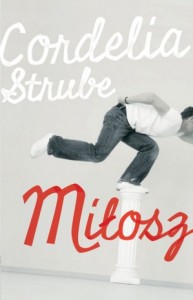 My review of Cordelia Strube’s new novel Milosz appears in the National Post this weekend. As I wrote, “At its heart, which is huge, Milosz is about progeny, about what tethers us to the world and to each other. ” You can the review in its entirety here.
My review of Cordelia Strube’s new novel Milosz appears in the National Post this weekend. As I wrote, “At its heart, which is huge, Milosz is about progeny, about what tethers us to the world and to each other. ” You can the review in its entirety here.
September 11, 2012
The Comics
 It’s true that from a very young age, I read the entire Saturday paper cover-to-cover, if by “the entire Saturday paper” you mean the Toronto Star comics supplement in all its glorious colour. I loved Blondie and Beetle Bailey, Family Circus and For Better or For Worse, The Better Half and Spiderman. I liked Broom Hilda, Dennis the Menace, Hi & Lois, and Hagar the Horrible, though I was confused by Little Orphan Annie because it wasn’t like the movie at all. I was depressed by Jon Arbuckle and Cathy, but read their strips anyway, and all the others I didn’t really understand– Ernie, and Mother Goose and Grimm, Shoe, and many others. In fact, it’s likely that I didn’t understand any of the comics, really, but it didn’t stop me from poring over them every Saturday morning, lying on the living room carpet in my pajamas. There was something in their colours and cartoonishness that made clear that this was my part of the paper; the comics were an invitation and an introduction to the pleasures of newspaper reading.
It’s true that from a very young age, I read the entire Saturday paper cover-to-cover, if by “the entire Saturday paper” you mean the Toronto Star comics supplement in all its glorious colour. I loved Blondie and Beetle Bailey, Family Circus and For Better or For Worse, The Better Half and Spiderman. I liked Broom Hilda, Dennis the Menace, Hi & Lois, and Hagar the Horrible, though I was confused by Little Orphan Annie because it wasn’t like the movie at all. I was depressed by Jon Arbuckle and Cathy, but read their strips anyway, and all the others I didn’t really understand– Ernie, and Mother Goose and Grimm, Shoe, and many others. In fact, it’s likely that I didn’t understand any of the comics, really, but it didn’t stop me from poring over them every Saturday morning, lying on the living room carpet in my pajamas. There was something in their colours and cartoonishness that made clear that this was my part of the paper; the comics were an invitation and an introduction to the pleasures of newspaper reading.
I do love newspapers, inky ones. When we lived in England, we used to buy so many weekend papers that getting them read was our chief occupation. And these days, we subscribe to the ever-shrinking Saturday Globe & Mail, and it’s still one of my favourite parts of Saturday morning, Tabatha Southey, tea, book reviews and croissants.
Lately Harriet’s got her own part of the paper, and she starts shouting for it as soon as I bring the paper in: “Comics! Comics!” Which is kind of funny because The Globe & Mail comics are mostly terrible, but Harriet doesn’t know and doesn’t care. She sees the cartoon pictures, and she thinks they’re for her. And so she makes us read the whole section aloud, some comics over and over. I don’t know if there has ever been a family so intent on Drabble. Sometimes the comics are even less terrible then you’d think, and when that happens, we’re always kind of amazed.
And thankfully, when the comics are too unfunny, we supplement Harriet’s hunger for them with regular trips to our local kids’ comics shop.


